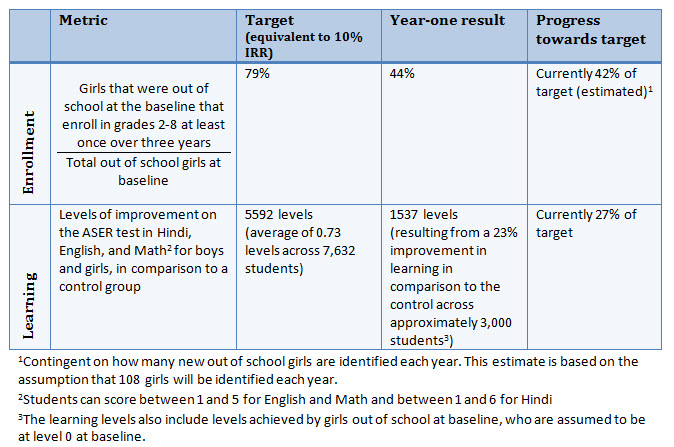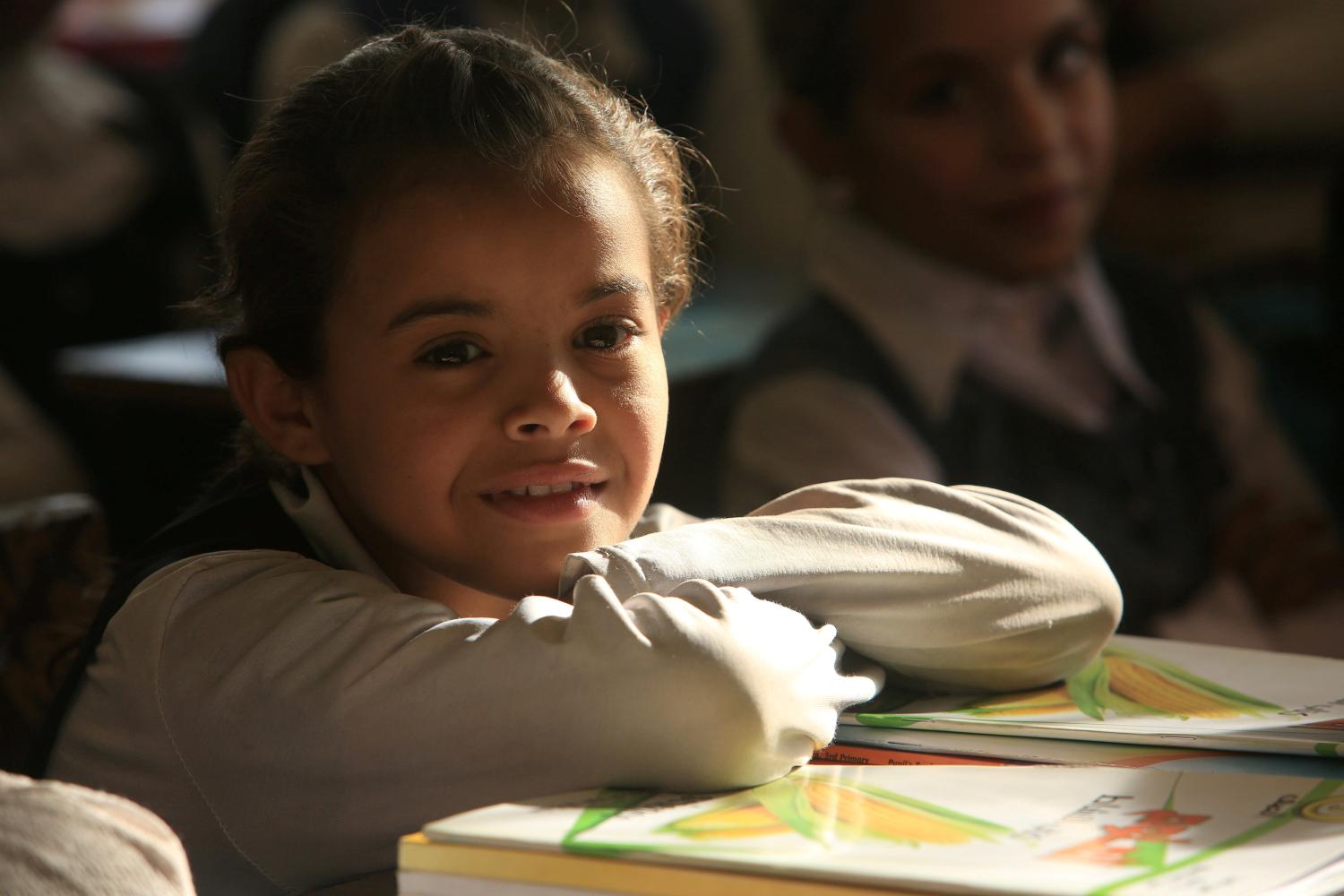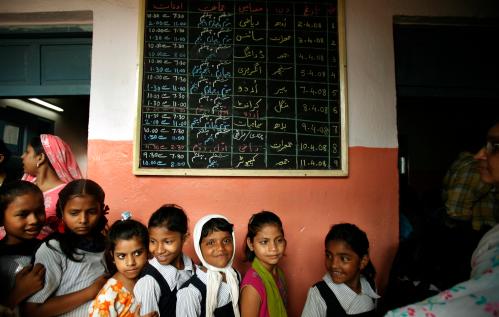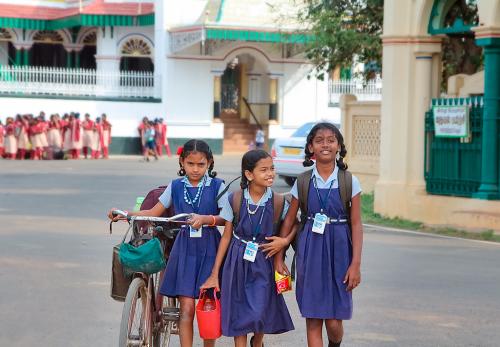On July 5, the results from the first year of the world’s first development impact bond (DIB) for education in Rajasthan, India, were announced. The Center for Universal Education hosted a webinar in which three stakeholders in the DIB shared their perspective on the performance of the intervention, their learnings about the DIB process, and their thoughts for the future of DIBs and other results-based financing mechanisms.
What is the social challenge?
Approximately 3 million girls ages 6 to 13 were out of school in India according to most recent data, 350,000 of which are in the state of Rajasthan. Child marriage is also a large issue in the state; no state-specific data exists, but nationwide 47 percent of girls ages 20 to 24 are married before age 18. According to Educate Girls, a non-governmental organization based in Rajasthan, girls’ exclusion is primarily a result of paternalistic societal mindsets and traditions. Given the evidence linking education and future life outcomes for girls, this data is greatly concerning.
What intervention does the DIB finance?
The DIB finances a portion of the services provided by Educate Girls, which has been working to improve enrollment, retention, and learning outcomes for girls (and boys) in Rajasthan since 2007. The organization trains a team of community volunteers ages 18 to 30 to make door-to-door visits encouraging families to enroll their girls in school and to deliver curriculum enhancement in public school classrooms. Their volunteers are present in over 8,000 villages and 12,500 schools in Rajasthan. The DIB was launched in March of 2015 to finance services in 166 schools, which represents 5 percent of Educate Girls’ annual budget. The DIB is intended to be a “proof of concept” of the mechanism using this relatively small selection of beneficiaries.
Who are the stakeholders in the Educate Girls DIB?
The investor in the DIB is UBS Optimus Foundation, who has provided $238,000 in working capital to fund the service delivery. ID Insight, a non-profit evaluation firm, will evaluate the improvement in learning of girls and boys in the treatment schools in comparison to a control group and will validate the number of out of school girls enrolled. The Children’s Investment Fund Foundation serves as the outcome funder, and has agreed to pay UBS Optimus Foundation 43.16 Swiss francs ($44.37) for each unit of improved learning and 910.14 francs ($935.64) for every percentage point increase in the enrollment of girls out of school. Instiglio, a non-profit impact bond and results-based financing intermediary organization, provided technical assistance to all parties during the design of the DIB and currently provides performance management assistance to Educate Girls on behalf of UBS Optimus Foundation.
What were the first-year results of the DIB?
The outcomes will be calculated in 2018, at the end of three years; however, preliminary results for the year since the launch of the DIB (representing multiple months of door-to-door visits and seven weeks of interventions in the classroom) were released last week. The payments for the DIB were structured such that the investor, UBS Optimus Foundation, would earn a 10 percent internal rate of return (IRR) on their investment at target outcome levels, which were based on Educate Girls’ past performance data. The table below presents the metrics, target outcome level, year-one result, and the progress toward the target.
Table 1: Educate Girls DIB Results from first year of services

What were the key learnings over the past year?
The DIB was challenging to implement and required DIB stakeholders to be resourceful.
First, the reliability of government data was a challenge, which necessitated flexibility in the identification of the target population and metrics. Second, given the number of stakeholders engaged and the novelty of this approach, the transaction costs were higher than they would have been for a traditional grant. This meant that strong and regular communication was crucial to the survival of the project.
The role of the outcome funder and investor were significantly different versus a grant.
The outcome funder spent more resources on defining outcomes, but spent fewer resources on managing grant activities. The investor utilized risk management and monitoring strategies informed by the activities in their commercial banking branch, which they have not used for other grants.
The DIB has changed the way the service provider operates.
In the video below, Safeena Husain from Educate Girls’ highlights the ways in which financing a portion of their program through a DIB differs from financing the program through grants. Safeena describes that in a grant, performance data is reported up to donors, but rarely makes it back down to frontline workers. The DIB has helped them to develop mobile dashboards that ensure performance data is reaching the front line and helping to identify barriers to outcomes as early as possible.
Based on the learnings from the implementation of the first DIB for education, this tool can be used to improve the value for money for the outcome funder and strengthen the performance management of a service provider. As the panelists discussed in the webinar, DIBs and other outcome-based financing mechanisms can help differentiate between organizations that are adept at fundraising and those that excel at delivering outcomes. However, service providers must be sufficiently prepared for rigorous outcome measurement if they plan to participate in a DIB; otherwise the high-stakes environment might backfire. In our research, we have closely examined the design constraints for impact bonds in the early childhood sector.
There are countless lessons to be learned from the stakeholder’s experience in the first DIB for education. We applaud the stakeholders for being transparent about the outcomes and true challenges associated with this mechanism. This transparency will be absolutely critical to ensure that DIBs are implemented and utilized appropriately moving forward.
The Brookings Institution is committed to quality, independence, and impact.
We are supported by a diverse array of funders. In line with our values and policies, each Brookings publication represents the sole views of its author(s).









Commentary
Educate Girls development impact bond could be win-win for investors and students
July 18, 2016